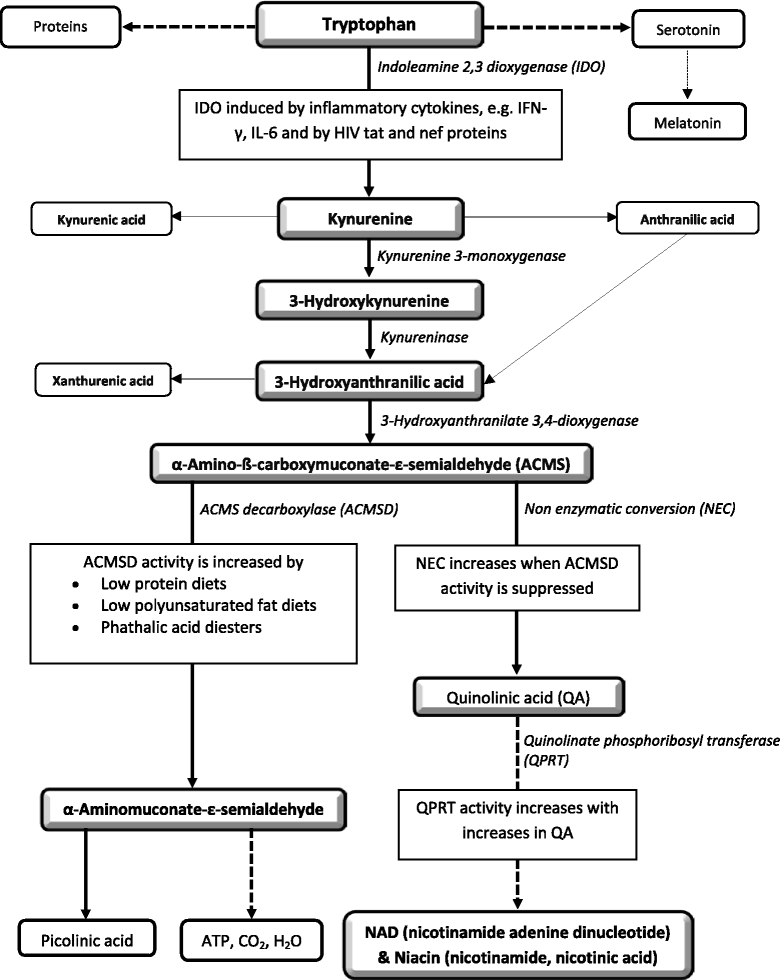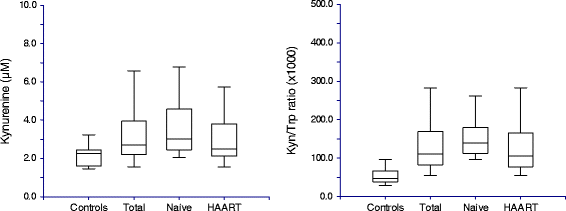The kynurenine pathway activities in a sub-Saharan HIV/AIDS population
- PMID: 26285873
- PMCID: PMC4545362
- DOI: 10.1186/s12879-015-1087-5
The kynurenine pathway activities in a sub-Saharan HIV/AIDS population
Abstract
Background: Tryptophan is an essential amino acid for the synthesis of proteins and important metabolites such as serotonin, melatonin, tryptamine and niacin. After protein synthesis, more than 90 % of tryptophan catabolism occurs along the kynurenine pathway. The inflammation-inducible enzyme indoleamine 2,3 dioxygenase (IDO) is responsible for the first rate-limiting step in the kynurenine pathway, i.e., oxidation of tryptophan to kynurenine. Excessive IDO activity in conditions such as HIV/AIDS may lead to tryptophan depletion and accumulation of metabolites downstream from kynurenine. Little is known about the kynurenine pathway of HIV/AIDS patients in sub-Saharan regions. This study, in a low income sub-Saharan HIV/AIDS population, examined the effects of activities in the kynurenine pathway on plasma levels of tryptophan, kynurenine and the neurotoxin quinolinic acid, and on de novo synthesis of nicotinamide.
Methods: Plasma samples were obtained from a cohort of 105 HIV patients and 60 controls. Kynurenine pathway metabolites were analysed using gas chromatography - mass spectrometry. ELISA and flow cytometry were used to assess plasma inflammatory markers.
Results: IDO activity, depletion of tryptophan, as well as accumulation of kynurenine and the neurotoxin quinolinic acid, were not only significantly greater in the patients than in the controls, but also markedly greater than in HIV/AIDS patients from developed countries. Tryptophan levels were 12.3 % higher, kynurenine levels 16.2 % lower, quinolinic acid levels 43.2 % lower and nicotinamide levels 27,2 % lower in patients on antiretroviral treatment than in antiretroviral-naïve patients. Patients' kynurenine pathway metabolites correlated with the levels of inflammatory markers, including that of the major IDO-inducer, interferon-gamma. Indications are that the rate of de novo synthesis of nicotinamide in the kynurenine pathway correlates with increases in quinolinic acid levels up to a point where saturation of the enzyme quinolinate phosphoribosyl transferase occurs.
Conclusions: Higher levels of inflammatory activity in this low income sub-Saharan HIV/AIDS population than in patients from developed countries lead to greater tryptophan depletion and greater accumulation of metabolites downstream from tryptophan with quinolinic acid levels often reaching levels associated with the development of HIV/AIDS-associated neurocognitive dysfunction. De novo synthesis of nicotinamide from quinolinic acid contributes to the maintenance of nicotinamide, and by implication NAD levels, in HIV/AIDS patients from low income populations. Antiretroviral treatment partially corrects disturbances in the kynurenine pathway.
Figures
References
Publication types
MeSH terms
Substances
LinkOut - more resources
Full Text Sources
Other Literature Sources
Medical
Research Materials




